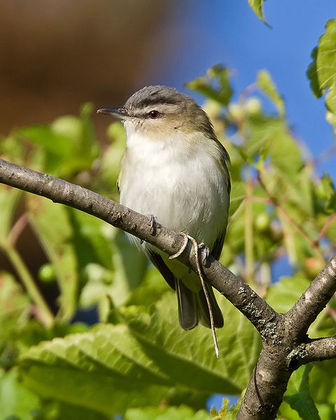Red-eyed Vireo
The Red-eyed Vireo, Vireo olivaceus, is a small American songbird, 13-14 cm in length. It is somewhat warbler-like but not closely related to the New World warblers . Common across its vast range, this species is not considered threatened by the IUCN.

Original source: Red-eyed VireoUploaded by Snowmanradio
Author: John Benson from Madison WI
The Red-eyed Vireo is classified as Least Concern. Does not qualify for a more at risk category. Widespread and abundant taxa are included in this category.
The Red-eyed Vireo, Vireo olivaceus, is a small American songbird, 13-14 cm in length. It is somewhat warbler-like but not closely related to the New World warblers (Parulidae). Common across its vast range, this species is not considered threatened by the IUCN. Description and systematics - Adults are mainly olive-green on the upperparts with white underparts; they have a red iris and a grey crown edged with black. More
-The red-eyed vireo builds a dainty little pensile nest suspended usually from a forking, horizontal branch of a shrub, or low branch of a tree, rather below the level of our eyes as we walk through second-growth. More
The Red-eyed Vireo has a large range, estimated globally at 12,000,000 square kilometers. Native to the Americas and nearby island nations, this bird prefers boreal, subtropical, or tropical forest ecosystems, though it can live on plantations or in degraded former forests. The global population of this bird is estimated at 140,000,000 individuals and does not show signs of decline that would necessitate inclusion on the IUCN Red List. For this reason, the current evaluation status of the Red-eyed Vireo is Least Concern. More
Red-eyed Vireo Range MapView dynamic map of eBird sightings Field MarksHelp - * AdultPopOutZoom In Adult * © Marie Read All About Birds > Bird Guide > Red-eyed Vireo Birding Basics * Bird Guide * Building Skills * Attract Birds * Favorite More
Turbo (Colombia): though only three Red-eyed Vireos were examined, all were infected with at least one of these parasites. Footnotes - 1. ^ BLI (2008) 2. ^ Henninger (1906), OOS (2004) 3. ^ Machado (1999) 4. ^ Foster (2007). Cymbopetalum mayanum (Annonaceae) is visited far less frequently. 5. ^ Pascotto (2006) 6. More
The Red-eyed Vireo is an inhabitant of the whole of our forests. More
The Red-eyed Vireo, Vireo olivaceus, has been one of the most abundant birds in North America, although its numbers seem to have declined recently - possibly as a result of the destruction of wintering habitat in the neotropics, fragmentation of northern breeding forests, or other causes. The Yellow-green Vireo, Vireo flavoviridis, of Central America is sometimes considered to be a subspecies of Red-eyed Vireo. More
The Red-eyed Vireo is a neotropical migrant so it is a resident of the United States and Canada only in the breeding season. It migrates long distances to winter in South America. The Red-eyed Vireo is among the most abundant breeding birds in North America as well as in the Park. During the breeding season, it is a tireless singer, singing from dawn to dusk - even in the heat of the day when most other songbirds are quiet. More
In spring, all ages and sexes of Red-eyed Vireo have a similar overall appearance, and it is necessary to view the wings and tail to distinguish among them. Photo by Marcel Gahbauer, May 2005 - One of the key distinguishing features of ASY Red-eyed Vireos is the presence of distinct green edging on fairly broad and rounded primary coverts, as shown in the photo below. More
considered red-eyed vireo an uncommon summer resident present 18 May to 22 September in Lincoln County. Rosche (1979) recorded red-eyed vireo in the lower North Platte River Valley 18-25 May, and on 25 August. Breeding Range: An uncommon to rare and local summer resident in the Platte River Valley physiographic region, and on the Eastern Plain; virtually absent elsewhere. Breeding Population: The 1979-1980 population was estimated at 300 breeding pairs. More
Red-eyed Vireo is a small bird, olive-green above, and pale yellow and white below. It has a rather prominent whitish supercilium, and distinctive grey crown. The supercilium is highlighted by both dark eye-stripe below, and a dusky lateral crown-stripe above. Adult has ruby-red iris, difficult to see in the fields. Juvenile has brown eyes, and this colour persists through the first winter. More
The Red-Eyed Vireo has olive green wings with a whitish-tan chest. Its beak is a gray or black color. It has eyebrow stripes that are black on a white border. The Red-Eyed Vireos are similar to the warbling vireos in appearance except it is smaller and paler. An average Red-Eyed Vireo is 6 inches long with a wingspan of 10 inches and weighs 17 grams. The male is a tireless singer that delivers at least 20,000 songs a day. More
North American RangeThe Red-eyed Vireo is a small bird, olive-green above and pale yellow and white below. It has no wing-bars. It has a rather flat head with a blue-gray crown, bordered below by three stripes: black, white, and black, with the lowest stripe passing through the eye. Although adults have bright red eyes, the color of the eyes is often difficult to detect in the field. The eyes of juveniles are brown, a color that may persist through the first winter. More
Confirmed Brown-headed Cowbird records where Red-eyed Vireo was indicated as host species. MinDate: 06/06 MaxDate: 08/21 for this species. More
The Red-eyed Vireo is a Neotropical migrant that makes its way from its home in Central and South America to the deciduous woodlands of North America to select a territory, win a mate and raise its young. Its persistent song of short individual phrases, as many as 40 to 60 per minute, is commonly heard in forests throughout the summer breeding season. More

Original source: Darrin OBrien
Author: Darrin OBrien
Permission: Some rights reserved
Family : Vireonidae
Genus : Vireo
Species : olivaceus
Authority : (Linnaeus, 1766)
